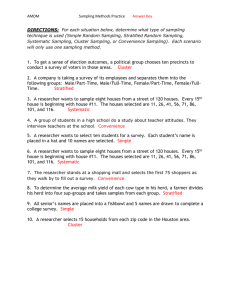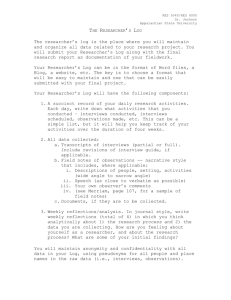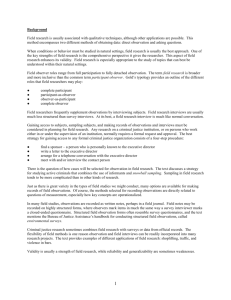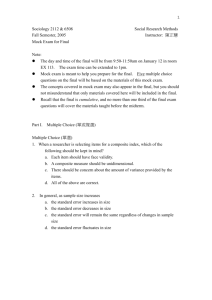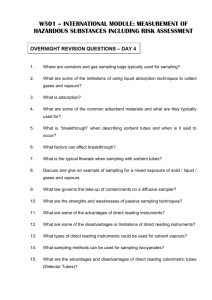Marketing Research
advertisement
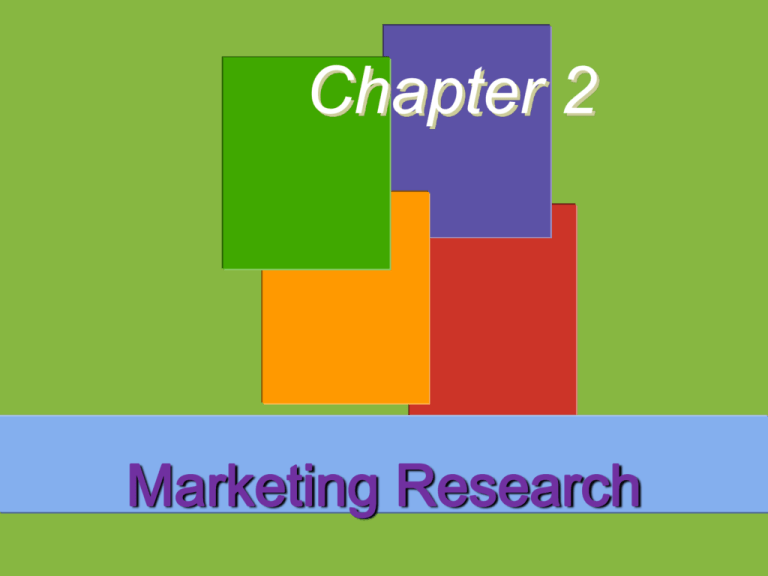
Chapter 2 Marketing Research 1-1 After studying this chapter, you should be able to: 1-2 Nature of marketing research. Define marketing research. Importance of marketing research. 6 steps in marketing research process. Problems emerging from marketing research. The Nature of Marketing Research? Can help the marketing manager to: (1) Identify and define marketing problems and opportunities accurately; (2) Understand markets and customers and offer reliable prediction about them; (3) Develop marketing strategies and actions to provide a competitive edge; and refine and evaluate them; (4) Facilitate efficient expenditure of funds; (5) Monitor marketing performance; and (6)Improve the understanding of marketing as a process. 1-3 What is Marketing Research? 1-4 Marketing Research: Systematic design, collection, analysis and reporting of data and findings relevant to a specific marketing situation facing the company. Marketing Research: • Specifies the information required to address these issues. • Designs the methods for collecting information. • Manages and implements the data collection process. • Analyzes the results. • Communicates the findings and implications. 1-5 Importance of Marketing Research: • Expand the market firms scope. • Increased competition. • Plan the firm strategy. • Increased use of technology. • Changing needs & wants requirements. 1-6 Marketing Research: Where 1-7 do you get the info? A. you can do it yourself by making someone in the company responsible for doing the research B. you can hire an outside agency that specializes in Market Research Marketing Research: There are 3 types of outside agencies (marketing research firms): 1. Syndicate-service research firms - these firms gather consumer and trade information, which they sell for a fee. - example: A.C. Nielsen Media Research. 2. Custom marketing research firms - these firms are hired to carry out specific projects. - they design the study and report the findings. 1-8 3. Specialty-line marketing research firms. - these firms provide specialized research services. - example: field-service firm, which sells field interviewing services to other firms Marketing Research: Small companies can hire the services of a marketing research firm or conduct research in creative and affordable ways, such as: 1-9 1. Engaging students or professors to design and carry out projects 2. Using the Internet 3. Checking out rivals The Marketing Research Process Six steps involved in marketing research process: • The problems in decision alternatives and the research objectives. • The research plan. • The information collection. • The information analysis. • Research findings. • Decision making. 1-10 Step 1: The Problem in Decision Alternatives and the Research Objectives Problem Definition: • The first step in any marketing research project and is critical to its success. All parties involved must: • Focus on the real research problem, not the symptoms. • • 1-11 Anticipate how the information will be used. Avoid prescribing a specific study until the problem is fully understood and defined. Marketing managers must be careful not to define the problem too broadly or too narrowly for the marketing researcher. Research Designs/Plan 1-12 Exploratory Research: • Typically carried out to satisfy the researcher’s desire for better understanding, or to develop preliminary background and suggest issues for a more detailed follow-up study. Descriptive Research: • Normally directed by one or more formal research questions or hypotheses. • Cross-sectional study • Longitudinal research Causal Research: • Experiments in which researchers manipulate independent variables and then observe or measure the dependent variable or variables of interest. Step 2: The Research Plan 1-13 The second stage of marketing research calls for developing the most efficient plan for the needed information. The marketing manager needs to know the cost of the research plan before approving it. Designing a research plan calls for decisions on the data sources, research approaches, research instruments, sampling plan and contact methods. Data Sources Primary Data 1-14 Secondary Data Data being collected for the first time. Previously produced or published matter. Data freshly gathered for a specific purpose or for a specific research project. Data that were collected for another purpose and already exist somewhere. Data Types Primary Data Secondary Data SURVEYS - Mail - Telephone INTERNAL DATA - Company records - Data from MDSS INTERVIEWS - Mall intercepts - Personal interviews EXTERNAL DATA Proprietary - Custom Research - Syndicated services Nonproprietary - Published reports - Census data - Periodicals FOCUS GROUPS - Personal - Mechanical 1-15 Research Approaches Observational Research - Focus Group Research - 1-16 Fresh data can be gathered by observing the relevant actors and setting. Consumers can be unobtrusively observed as they shop or as they consume products. Gathering of 6 to 10 people who are carefully selected based on certain demographic, psychographic or other considerations and brought together to discuss various topics of interest at length. Participants are normally paid a small sum for attending. Research Approaches Survey Research - Behavioral Data Customers leave traces of their purchasing behavior in store - 1-17 Companies undertake surveys to learn about people’s knowledge, beliefs, preferences, satisfaction and to measure these magnitudes in the general population. scanning data, catalog purchases and customer databases. Customers’ actual purchases reflect preferences and often are more reliable than statements they offer to market researchers. People may report preferences for popular brands, and yet the data show them actually buying other brands. Research Approaches Experimental Research The most scientifically valid research is experimental - 1-18 research. To capture cause-and-effect relationships by eliminating competing explanations of the observed findings. To the extent that the design and execution of the experiment eliminate alternative hypotheses that might explain the results, research and marketing managers can have confidence in the conclusions. Research Instruments Questionnaires - Qualitative Measures - 1-19 A set of questions presented to respondents. Gauging consumer opinion because consumer actions do not always match their answers to survey questions. Qualitative research techniques – unstructured measurement approaches that permit a range of possible responses. Research Instruments Qualitative Measures - 7 techniques employed by design firm IDEO for understanding the customer experience: 1. Shadowing - observing people using products, shopping, going to hospitals, taking the train, using cell phones. 2. Behavior mapping - photographing people within a space, such as a hospital waiting room, over two or three days. 1-20 Research Instruments 3. Consumer journey - keeping track of all the interactions a consumer has with a product, service or space. 4. Camera journals - asking consumers to keep visual diaries of their activities and impressions relating to a product. 5. Extreme user interviews - talking to people who really know or know nothing about a product or service and evaluating their experience using it. 1-21 Research Instruments 6. Storytelling - prompting people to tell personal stories about their consumer experiences. 7. Unfocus Group - interviewing a diverse group of people: to explore ideas about sandals, a bodybuilder, a podiatrist and a shoe fetishist. 1-22 Research Instruments Mechanical Devices - 1-23 Occasionally used in marketing research. Example: galvanometers can measure the interest or emotions aroused by exposure to a specific ad or picture. Types of Survey Research Questions 1-24 Scaled • • Likert agree-disagree Semantic differential Multichotomous (multiple choice) Categorical Open-ended Five Errors in Question Design 1. 2. 3. 4. 5. 1-25 Double-barreled wording Loaded wording Ambiguous wording Inappropriate vocabulary Missing alternatives Sampling Plan 1-26 Sampling Unit - who is to be surveyed? Sample Size - how many people should be surveyed? Sampling Procedure - how should the respondents be chosen? Sampling Probability Sampling • Simple random sampling - every member of the population has an equal chance of selection. • Stratified sampling - the population is divided into mutually exclusive groups (such as age group) and random samples are drawn from each group • Cluster sampling - the population is divided into mutually exclusive groups (such as city blocks) and the researcher draws a sample of the groups to interview. 1-27 Sampling Nonprobability Sampling • Convenience sample - the researcher selects the most accessible population members. • Judgment sample - the researcher selects population members who are good prospects for accurate information. • Quota sample - the researcher finds and interviews a prescribed number of people in each of several categories. 1-28 Contact Methods Mail Questionnaire - the best way to reach people who would not give personal interviews or whose responses might be biased or distorted by the interviewers. Telephone Interview the best method for gathering information quickly; the interviewer is also able to clarify question if respondents do not understand them. 1-29 Contact Methods Personal Interview - - Online Interview - - 1-30 the interviewer can ask more questions and record additional observations about the respondent, such as dress and body language. most expensive method and requires more administrative planning and supervision. A company can include a questionnaire on its Web site and offer an incentive to answer the questionnaire; or it can place a banner on some frequently visited. Example: Yahoo – inviting people to answer some questions and possibly win a prize. Step 3: The Information Collection • • 1-31 The data collection phase of marketing research is generally the most expensive and the most prone to error. In the case of survey, 4 major problems arise: i. Some respondents will not be at home and must be contacted again or replaced. ii. Other respondents will refuse to cooperate. iii. Others will give biased or dishonest answers. iv. Interviewers will be biased or dishonest. Step 3: The Information Collection/Fieldwork 1-32 Fieldwork is the process of: • Contacting respondents • Conducting interviews • Completing surveys Step 4: The Information Analysis Extract findings from the collected data Techniques for analyzing marketing research data: • • • • • 1-33 Tabulates the data and develops frequency distributions Averages and measures of dispersion are computed for the major variables. Means Percentages Complex multivariate statistical tests Step 5: Research Findings 1-34 As the last step, the researcher presents the findings. The researcher should present findings that are relevant to the major marketing decisions facing management. Step 6: Decision Making 1-35 Step 6: Decision Making • The managers who commissioned the research need to weigh the evidence. • If their confidence in the findings is low, they may decide against the problems. • A growing number of organizations are using a marketing decision support system to help their marketing managers make better decisions. 1-36 Marketing Decision Support Systems (MDSS) 1-37 MDSS Are Designed to: Support not supplant management decision marketing. Apply to semi structured decisions of middle and upper management (pricing, promotion, and location decisions). 1-38 MDSS Are Designed To: 1-39 Provide interaction between and among people and systems. Center on a segment of related decisions (the allocation of marketing effort and resources). Be user-friendly. Problem Emerging From Marketing Research 1. 2. 3. 4. 5. 1-40 A narrow conception of the research. Uneven caliber of researchers. Poor framing of the problem. Late and occasionally erroneous findings. Personality and presentational differences





